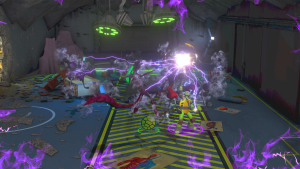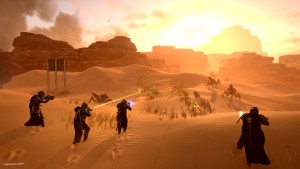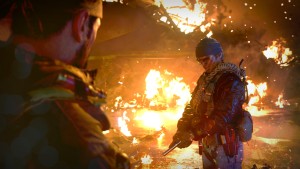Please support Game Informer. Print magazine subscriptions are less than $2 per issue
Elder Gods In The Machine – Darkest Dungeon’s Lovecraftian Game Mechanics

Darkest Dungeon is dripping with H.P. Lovecraft: inky alien tentacles protrude through dimensional rifts in the game’s fetid sewers, your characters’ sanity is steadily drained as they trudge further into the darkness, and Wayne June (the narrator of several Lovecraft audiobooks) provides a fraught basso narration throughout it all.
While it’s been out since the beginning of the year on PC, Red Hook Studios’ Darkest Dungeon is now available for PlayStation 4 and Vita, which makes this a perfect opportunity to talk about one of the most interesting games to emerge from Steam’s Early Access program. Daniel Tack reviewed the game in January, praising Darkest Dungeon’s substance and style, and calling it "an incredible take on the classic dungeon crawl."
As the game begins, you find you’ve inherited a decrepit manor from a relative who died after his quest for riches beneath the estate opened gateways to evil dimensions. Your job is to clean up the mess he left behind – or more accurately, to hire other people to do it for you, and hopefully find some of that treasure your forebear was after.
Darkest Dungeon isn’t just outwardly Lovecraftian – that is, it’s not simply a well-made dungeon crawl covered in a coat of Cthulhu-colored ink. The game’s mechanics themselves are rooted in themes that are integral to Lovecraft’s particular brand of horror, and the result is an experience that can be deeply –and rewardingly – unsettling.
The Basics of Lovecraft
Even if you’ve never read any of Lovecraft’s fiction, you’ve almost certainly felt his far-reaching influence. He wrote about creepy cults and terrible alien gods that sleep beneath the sea, about ancient tomes full of knowledge that drive readers insane, and about deranged scientists who reanimate the dead. The Shadow over Innsmouth introduces the creepy New England town referenced in many of Lovecraft’s stories, where residents were suspicious of outsiders and had a certain "fishy" look about them. In The Call of Cthulhu, which is a good entry point into Lovecraft’s work, he details much of his famous mythos of terrifying "elder ones" from beyond the stars, and the cults that seek to reawaken them.
"Lovecraftian horror" as a genre has long since eclipsed the author’s own extensive body of work. And in many ways, that’s a good thing: written in the 1920s and ‘30s, many of Lovecraft’s stories reflect an unreconstructed racism that can be pretty tough to read. The Rats in the Walls, which is the inspiration for Darkest Dungeon’s setting, is a perfect example of this – the narrator uses a vile racial slur as the name for his black cat. Fortunately, storytellers who’ve followed in Lovecraft’s footsteps (including Darkest Dungeon’s writers) have felt free to leave this aspect of the author’s work in the past and continue exploring his more creative ideas about malevolent alien gods from outside space and time.
Former Game Informer intern AJ Moser compiled a great list of Lovecraft-inspired games, and he hits on several of the author’s main themes: fear of the unknown, the loss of sanity, and the insignificance of humanity compared to cosmic forces. Darkest Dungeon uses these three Lovecraftian motifs to shape its mechanics, so let’s look at them one by one.

Fear of the Unknown
Throughout history, humans have feared the darkness, and to Lovecraft it represented the unknown and unknowable. Many of his stories center on forbidden knowledge hidden in darkness, notably The Call of Cthulhu. Lovecraft’s monsters and cultists crave the darkness, relying on it to help protect them and the secrets they guard. His characters rarely survive contact with the dark, and the ones who do are permanently scarred from the experience.
Games like the original Thief, Outlast, Alien: Isolation, and countless others have used darkness to effectively create unnerving or downright terrifying environments. But in Darkest Dungeon darkness is actually a gameplay mechanic: the darker it gets, the more likely it is that you’ll get ambushed by a group of enemies as you travel between rooms. Darkness also increases your characters’ stress levels. But while the darkness is dangerous, it also has a definite allure. As the light level gets lower, the loot you pick up becomes better and better, and while monsters gain certain advantages in the dark, your characters also have increased chances to score critical hits in combat. Your party can bring torches along to light the way, but these must usually be purchased before an expedition begins, they burn out quickly, and they take up limited inventory space. The game creates a push-pull against the darkness that is full of risks and rewards, but it also reflects Lovecraft’s simultaneous fear of and fascination with darkness.
The procedural generation of each dungeon adds to this tension. Each time you set out on a new expedition, the layout of rooms and hallways is brand new. You can usually only guess which direction your characters should travel, and the map reveals little beyond what you’ve already explored – although you can increase the chance of “scouting ahead” and revealing more of the map by keeping a fully-lit torch at the ready. No matter how well you prepare for a quest, and no matter how many times you’ve already attempted it, each time you set forth in Darkest Dungeon you’re heading into darkness and the unknown.
Your characters encounter enemies in the sewers and warrens below the estate that grow increasingly horrible as you progress through the game. Brigands and ghouls prowl the early areas, but as your party pushes deeper into the dungeons, they’ll run into twisted half-human monsters, eyeless acolytes of evil gods, and fungal abominations. They’re the kinds of horrors we’ve always imagined lurking just beyond the reach of the campfire’s light.
Loss of Sanity and Humanity
Monsters and traps aren’t the only dangers your characters face in Darkest Dungeon. There’s also stress, mentioned above, which builds as the party walks through the dark or when members suffer critical hits. Certain enemies inflict "stress damage" rather than physical damage, implying that they’re attacking characters' minds rather than their bodies. Just being in the dungeons is inherently stressful for all but the most experienced explorers. Stress, along with the various diseases, parasites, and syndromes your characters can pick up on their way through the underground caverns, persists between adventures and can have long-term effects on their health, behavior, and effectiveness. Managing who is getting treated for which ailment can be a tricky balancing act to pull off between expeditions, and you’ll often find yourself (particularly in the early game) sending characters back into the field before they’ve had a chance to truly recover.
This in itself isn’t particularly new territory for RPGs or management games, but the game’s tuning tests the player’s humanity as much as the characters’ toughness. As more characters amass longer and longer lists of physical and mental ailments from their time in the dungeons, you have to make increasingly uncomfortable choices. Your high-level Crusader might have just returned from a particularly costly expedition and still be completely stressed out, or you might need to send a brand new Vestal (a healing class) in with a more experienced crew on a tougher mission, knowing she probably won’t survive. As Austin Walker wrote in his Darkest Dungeon essay for Paste, “If this were a game of Call of Cthulhu, you’d be the antagonist – the fallen aristocrat so thirsty to recover his family’s power that he sacrifices the lives of dozens to unearth terrible, terrible things.”
Sending characters to their certain doom is uncomfortable, but it’s definitely Lovecraftian. The author’s protagonists very rarely survive to the end of one of his short stories. One of his contemporaries, Robert Bloch, wrote a story called The Shambler from the Stars, in which he kills off a character that he’d obviously based on Lovecraft himself. Lovecraft responded by penning the short story The Haunter in the Dark as a sequel to Bloch’s. Its main character, a writer named Robert Blake, unwittingly activates an ancient relic and summons a monster from another dimension. The nameless horror, which drives Blake insane and eventually kills him, can only move in total darkness.

Powerlessness
In Lovecraft’s stories, the takeaway is often that humanity’s best efforts are ultimately futile in the face of powers that we can’t begin to comprehend. There’s a built-in unfairness and hopelessness in his stories. Building a sense of powerlessness and futility into a game’s mechanics cuts against some core tenets of game design – what’s the point in playing a game if it’s impossible to complete? Darkest Dungeon is a difficult game, but not impossible, and it manages to hint at humanity’s frailty and weakness without stopping the player’s progress.
One way the game does this is by using a probability system similar to the one found in XCOM: Enemy Unknown and countless other turn-based games. Your Arbalest may have a 70-percent chance to hit an enemy in the back row of a group of monsters, and that information is given to you right up front. This means you’re constantly managing risk instead of making moves that have definite outcomes – it might make sense in some cases to take a 25-percent chance to hit shot just in case it saves another party member from taking a fatal blow.
But this means that playing Darkest Dungeon optimally doesn’t always yield optimal results. Despite doing everything right, your party still faces the possibility of permanent injury or death. The only real guarantee is that your characters will definitely suffer a cost, mental and physical, from their adventures in the catacombs.
Characters who persevere through many adventures will get stronger and capable of taking on tougher challenges, but the risk of losing them remains throughout the game. And when the dungeons don’t consume characters, sometimes their own mental demons will do the job. A character who has built up too many negative traits may simply become too expensive to treat, and you’ll have to cut him loose to free up roster space. Sending these broken characters away to wander the world with afflictions you’ve pushed on them is chilling in the way that losing a valued member of an XCOM squad is heartbreaking.
As the in-game weeks roll by, you can recognize a creeping unease building in yourself as well. Your heroes aren’t cut out for the next mission. And what if you have to train up a new team? Can you actually move forward in the game, or has a mistake two expeditions ago doomed your playthrough? You don’t have a choice but to press forward, but that nagging voice will always remind you that success is anything but guaranteed.
* * * * *
Howard Phillips Lovecraft died of intestinal cancer in 1937, having never achieved financial success with his fiction. But his influence is ubiquitous today: H.R. Giger’s design for the Xenomorph in Alien, for instance, and the terrible cosmic mystery of Bloodborne are both explicitly Lovecraftian. Darkest Dungeon’s presentation also exudes Lovecraft’s aesthetic thanks in no small part to dark, angular character designs and backgrounds and moody score.
The game isn’t content to simply look and sound Lovecraftian, though. Darkest Dungeon is a master class in design synthesis, pulling together aesthetic and mechanical elements into a thematically-unified whole that evokes the author’s work both in style and form. It’s enough that a few hours with the game may drive you to start feverishly scribbling notes in a journal to leave as a warning to anyone who might come looking for you…
Darkest Dungeon is out now for PlayStation 4 and PS Vita, and the first DLC, The Crimson Court, is scheduled for early next year.










